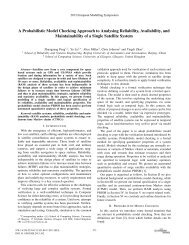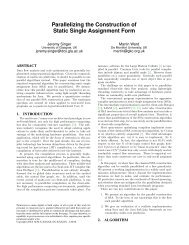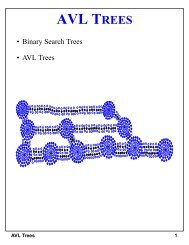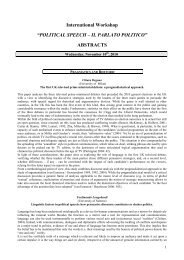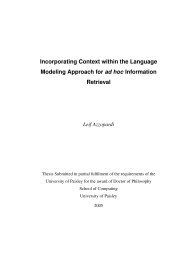Development and Implementation of a File System for Gannet Virtual ...
Development and Implementation of a File System for Gannet Virtual ...
Development and Implementation of a File System for Gannet Virtual ...
Create successful ePaper yourself
Turn your PDF publications into a flip-book with our unique Google optimized e-Paper software.
explained above are not suitable <strong>for</strong> <strong>Gannet</strong> file system since the size <strong>of</strong> metadata is<br />
128 bytes which consumes considerable amount <strong>of</strong> space <strong>for</strong> RAM-based file system.<br />
Another approach to save space consumption <strong>for</strong> metadata has presented by<br />
Conquest (Wang et al. 2006). It removes the nested indirect blocks from the inode,<br />
thus the data blocks are accessed through dynamically allocated index array which<br />
contains pointer to on data block. However, this approach only allows Conquest to<br />
store small files inside the RAM <strong>and</strong> have to store the larger files on static disk.<br />
Furthermore, to minimize the size <strong>of</strong> memory used <strong>for</strong> metadata, Conquest uses a<br />
stripped down version <strong>of</strong> st<strong>and</strong>ard metadata structure that used in disk. As it only<br />
contains fields that required con<strong>for</strong>ming to POSIX, the size <strong>of</strong> Conquest inode is 53<br />
bytes long. The major drawback <strong>of</strong> Conquest inode is only small files can be<br />
accommodated on RAM the file system as the metadata only contain direct pointer<br />
on dynamically indexed array.<br />
Another scheme to minimize the size <strong>of</strong> metadata also presented by HeRMES (Miller<br />
et al. 2001). It uses the same version <strong>of</strong> st<strong>and</strong>ard metadata which used in disk, but<br />
be<strong>for</strong>e the inodes are stored in RAM, HeRMES uses compression techniques to<br />
minimize the size <strong>of</strong> inodes. The major drawback is the overhead occurs in every<br />
time the inodes are accessed.<br />
According to Giampaolo (1999), generally an inode will store between 4 <strong>and</strong> 16<br />
block references directly. There is a trade<strong>of</strong>f between the size <strong>of</strong> the inode <strong>and</strong> how<br />
much data that inode can map. Storing a few block addresses directly in the inode<br />
simplifies finding file data as most engineering files tend to weigh under few<br />
kilobytes (Ousterhout et al. 1985, Satyanarayanan 1981). Furthermore, <strong>Gannet</strong> file<br />
system will operate on embedded environment which the average <strong>of</strong> most files tend<br />
to be smaller. Thus, in default configuration the inode <strong>for</strong> <strong>Gannet</strong>FS file system will<br />
store 3 block direct references to address <strong>and</strong> an indirect block. <strong>Gannet</strong>FS does not<br />
contain triple indirect block as files on embedded <strong>and</strong> RAM environment will not<br />
exceed the maximum size <strong>of</strong> double indirect block.<br />
16




